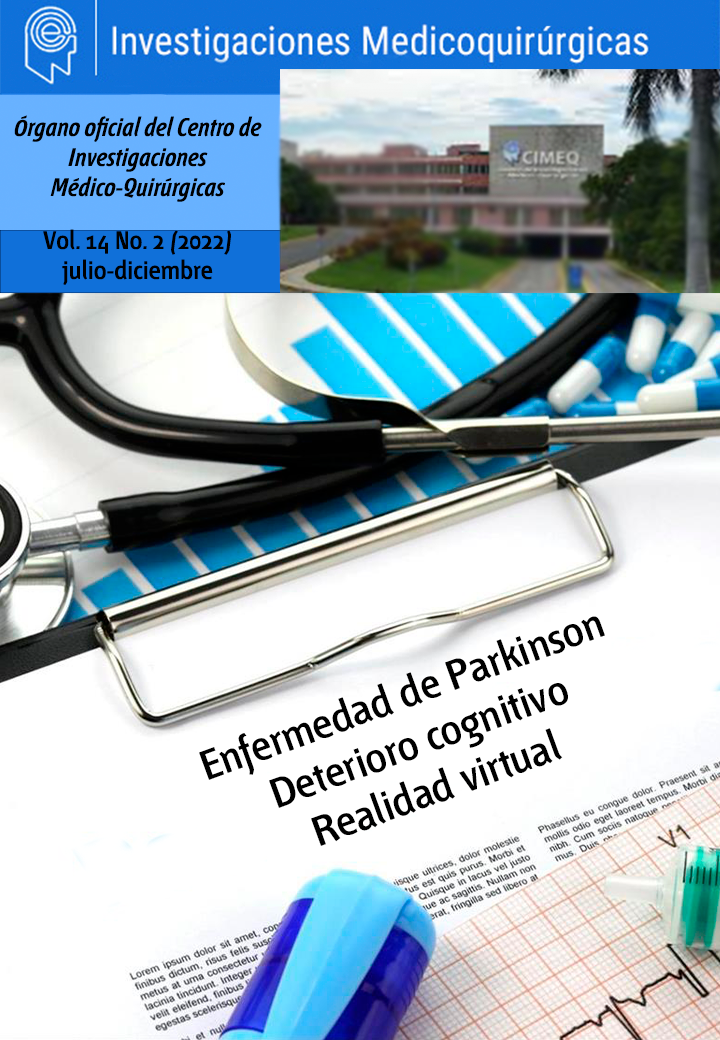The occupational therapy for the increase of the force in patient with cervical medullary lesions
Keywords:
rehabilitation, ischemic vascular brain disease, reading comprehension, software, adultsAbstract
Introduction: Reading ability is one of the fundamental elements for the reinsertion of adults into society. On the other hand, it is very common to alter reading comprehension in the population that is received at the International Center for Neuro-logical Restoration whose mission is to improve the quality of life of adults with sequelae of neurological diseases. In professional practice, there are frequent disorders in cognitive processes and in many cases difficulties in understanding texts.
Methods: Two groups were randomly selected with 15 patients each. The advantages of the computer in relation to the conventional method were demonstrated by the experiment.
Conclusions: This technological proposal constitutes one of the most important tools in the defective treatment of text comprehension in adults with Ischemic Vascular Brain Disease.
References
Casado M. Análisis Comité del Grupo de Estudio de Enfermedades Cerebrovasculares. Guía para el diagnóstico y tratamiento del lctus. Prous Science Barcelona; 2006.
Rodríguez JM et al. «Comportamiento de la enfermedad cerebrovascular en un período de dos años», en revista Rev. Cub. Med. Mil. 2006;35(4).
Luria A.R. Restoration of a function after a brain injury. New York: The Macmillan Cumpany, (1963).
Vega SD. Neurotrauma en Camagüey. Rev Cubana Cir. 2002; 42:120
Departamento de informática médica. Restauración neurológica: Clínica de Lesiones Estáticas Encefálicas del adulto; CIREN. [sitio en Internet]. Infomed. Disponible en http://www.ciren.cu/clinestat.htm. Acceso el 17 de enero de 2016.
Trujillo L. Ministerio de Educación. Dirección de Formación y Perfeccionamiento de Personal Pedagógico. Fundamentos de defectología. La Habana: Pueblo y Educación; 1996. pp. 7-16
Sentmanat A. Sistema de neurorrehabilitación multifactorial intensiva. [Tesis doctoral]. Ciudad de la Habana, Cuba: Instituto Superior Pedagógico Enrique José Varona; 2004.
Torres O. Estrategia pedagógica para la rehabilitación neurológica [Tesis doctoral]. Ciudad de la Habana, Cuba: Instituto Superior Pedagógico Enrique José Varona; 2008.
Svietkova L. Rehabilitación en los casos de lesiones focales del cerebro. Ciudad de La Habana, Cuba: Pueblo y Educación; 1985. p.195.
Bergado JA, Almaguer W. [Cellular mechanisms of neuroplasticity.] R ev Neurol; (2000). 31:1074- 95.
Vigotsky LS. Obras Completas V. La Habana: Pueblo y Educación; 1995.
Roméu A. Teoría y práctica del análisis del discurso. Su aplicación en la Enseñanza. Editorial Pue-blo y Educación. La Habana, 2003.
Domínguez, I y otros. Lenguaje y comunicación. La Habana, Editorial Pueblo y Educación; 2014.
Software para la rehabilitación cognitiva de niños y adultos con trastornos neurológicos. Disponible en: www.innovacionessoftware.com el 27 abril de 2014.
Boys O, La rehabilitación del primer nivel de la comprensión de lectura en adultos con lesiones estáticas encefálicas [Tesis doctoral]. La Habana, Cuba: Instituto Superior Pedagógico Enrique José Varona; 2017.
Mieke W. Aphasia rehabilitation and the role of computer technology: Can we keep up with modern times? International Journal of Speech-Language Pathology, 2011; 13(1): 21–27.
Downloads
How to Cite
Issue
Section
License
The authors retain copyright and all unrestricted publication rights.
Medicoquirúrgicas Research is licensed under the Creative Commons Attribution-Noncommercial 4.0 International License (CC BY-NC 4.0) and follows the SciELO Publishing Schema (SciELO PS) for publishing in XML format.
You are free to:
- Share — copy and redistribute the material in any medium or format.
- Adapt — remix, transform, and build upon the material.
The license cannot revoke these freedoms as long as you follow the license terms.
Under the following terms:
- Attribution — You must give appropriate credit, provide a link to the license, and indicate if changes were made. You may do this in any reasonable manner, but not in any way that suggests the licensor endorses you or your use.
Non-Commercial — You may not use the material for commercial purposes.
No Additional Restrictions — You may not apply legal terms or technological measures that legally restrict others from making any use permitted by the license.
Notices:
You do not have to comply with the license for elements of the material in the public domain or where their use is permitted by an applicable exception or limitation.
No warranties are given. The license may not give you all the permissions you need for your intended use. For example, other rights such as publicity, privacy, or moral rights may limit how you use the material.



